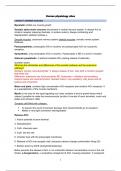Summary
Summary Human Physiology with practice exam questions - Human Physiology (WBFA022-03)
- Course
- Institution
- Book
Summary that contains all the information from the lectures and the book Human Physiology. Covers all the important headlines and has a detailed practice exam questions with clear explanation including pictures
[Show more]




